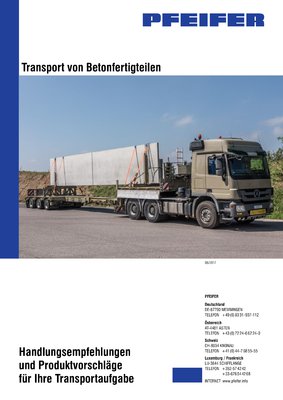Technical data
Standard
(VDI 2700 sheet 14)Operating temperature
–40 °C to +120 °CCoefficient of sliding friction
µ 0.6 at a surface pressure of up to 250 t/m²Load types Anti-Slip underlays
Standard loadsHandling
1.The contact between the friction partners must be maintained in every driving situation.
2.In order to achieve the optimum slip inhibition, the contact areas (load and loading surface) must be dry, clean and free from ice and grease.
3.Intermediate layers must also be provided with anti-slip mats.
4.Anti-slip mats must be designed such that the load and the underlying loading surface do not touch each other. It is not necessary to lay out the entire loading surface with anti-slip mats.
5.The friction coefficient attainable under practical conditions depends on the material pairing, the temperature, the condition of the material surfaces and the anti-slip mat.
Downloads
Description
-
Technical data
Technical data
Standard
- (VDI 2700 sheet 14)
Operating temperature
- –40 °C to +120 °C
Coefficient of sliding friction
- µ 0.6 at a surface pressure of up to 250 t/m²
Load types Anti-Slip underlays
- Standard loads
-
Handling
Handling
1.The contact between the friction partners must be maintained in every driving situation.
2.In order to achieve the optimum slip inhibition, the contact areas (load and loading surface) must be dry, clean and free from ice and grease.
3.Intermediate layers must also be provided with anti-slip mats.
4.Anti-slip mats must be designed such that the load and the underlying loading surface do not touch each other. It is not necessary to lay out the entire loading surface with anti-slip mats.
5.The friction coefficient attainable under practical conditions depends on the material pairing, the temperature, the condition of the material surfaces and the anti-slip mat.
-
Downloads
Downloads
Description
Technical data
Standard
(VDI 2700 sheet 14)Operating temperature
–40 °C to +120 °CCoefficient of sliding friction
µ 0.6 at a surface pressure of up to 250 t/m²Load types Anti-Slip underlays
Standard loadsHandling
1.The contact between the friction partners must be maintained in every driving situation.
2.In order to achieve the optimum slip inhibition, the contact areas (load and loading surface) must be dry, clean and free from ice and grease.
3.Intermediate layers must also be provided with anti-slip mats.
4.Anti-slip mats must be designed such that the load and the underlying loading surface do not touch each other. It is not necessary to lay out the entire loading surface with anti-slip mats.
5.The friction coefficient attainable under practical conditions depends on the material pairing, the temperature, the condition of the material surfaces and the anti-slip mat.
Downloads
Description
-
Technical data
Technical data
Standard
- (VDI 2700 sheet 14)
Operating temperature
- –40 °C to +120 °C
Coefficient of sliding friction
- µ 0.6 at a surface pressure of up to 250 t/m²
Load types Anti-Slip underlays
- Standard loads
-
Handling
Handling
1.The contact between the friction partners must be maintained in every driving situation.
2.In order to achieve the optimum slip inhibition, the contact areas (load and loading surface) must be dry, clean and free from ice and grease.
3.Intermediate layers must also be provided with anti-slip mats.
4.Anti-slip mats must be designed such that the load and the underlying loading surface do not touch each other. It is not necessary to lay out the entire loading surface with anti-slip mats.
5.The friction coefficient attainable under practical conditions depends on the material pairing, the temperature, the condition of the material surfaces and the anti-slip mat.
-
Downloads
Downloads
Description
 de
de
 en
en

